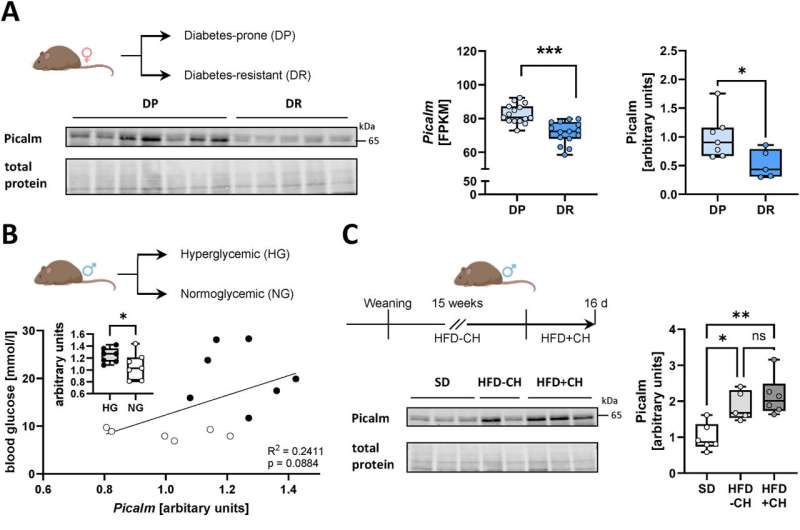
The role of the adapter protein PICALM (phosphatidylinositol-binding clathrin assembly protein) in the development of Alzheimer’s disease is well documented. Researchers from the German Institute of Human Nutrition Potsdam-Rehbruecke (DIfE), the German Center for Diabetes Research (DZD), ETH Zurich and the University of Cambridge have now for the first time studied the role of PICALM in white adipose tissue and its importance for metabolic health. They demonstrated that a reduced expression of PICALM improves insulin sensitivity and glucose transport in fat cells.
These results, which were recently published in Molecular Metabolism, could contribute to the development of new therapeutic approaches for treating type 2 diabetes and obesity.
White adipose tissue, once considered merely a fat storage depot, is now recognized as an endocrine organ that plays a central role in metabolism. Obesity-driven white adipose tissue dysfunction is one of the main causes of type 2 diabetes (T2D).
Although adipose tissue only takes up around 5% of postprandial glucose and is therefore not directly responsible for reducing blood sugar levels, the insulin-stimulated uptake of glucose into fat cells (adipocytes) plays a crucial role. It is a key component in the finely tuned energy homeostasis of adipocytes and disturbances to this process can cause adipocytes to release more fatty acids into the bloodstream, which can lead to fat deposits in organs such as the liver and muscles.
Exploring the regulatory mechanisms of glucose uptake
In recent years, it has been appreciated that insulin resistance and associated metabolic disorders are presumably mainly attributed to impaired insulin-stimulated glucose uptake via GLUT4, rather than to defects in proximal insulin signaling. Consequently, elucidating the metabolic pathways associated with the GLUT4 transporter represents a promising avenue for discovering new therapeutic targets.
In preliminary studies, the DIfE team headed by PD Dr. Heike Vogel used transcriptome analyses to identify phosphatidylinositol binding clathrin assembly protein (PICALM) as one of the genes with the strongest expression differences in the adipose tissue of diabetes-prone and diabetes-resistant mice. PICALM is a well-known susceptibility gene for Alzheimer’s disease and encodes an adapter protein that is ubiquitously expressed, i.e. in every cell. However, its role in adipose tissue and metabolic health had not been studied until now.
Combined methods in mouse, man and cell provide insight
The research team investigated whether there is a link between reduced expression of PICALM in white adipose tissue and improved glucose homeostasis.
In order to better understand the role of PICALM in metabolic regulation and its potential as a therapeutic target for obesity and T2D, the DIfE scientists combined a variety of methods. For example, they compared the expression of PICALM in the white adipose tissue of diabetes-prone and diabetes-resistant mice as well as people with different body mass indexes.
In addition, the team also examined the extent to which PICALM expression can be influenced by dietary interventions, such as intermittent fasting in mice and bariatric surgery in people with obesity. In a cell culture model, they manipulated PICALM levels in premature (preadipocytes) and mature fat cells in order to investigate the effects on the translocation of the glucose transporter GLUT4 from an intracellular reservoir to the cell surface, insulin signaling and adipogenesis.
PICALM as a highly promising target for improving glucose homeostasis
The results show for the first time that PICALM regulates both GLUT4 translocation and insulin signaling in adipocytes. Interestingly, a reduced expression of PICALM results in amplified insulin-stimulated GLUT4 translocation and insulin signaling. The researchers demonstrated that PICALM also affects the maturation of fat cells, which suggests distinct roles in preadipocytes and mature adipocytes.
“Here, we are describing a new role of the adapter protein PICALM in the regulation of glucose homeostasis and insulin signaling. Particularly noteworthy is the finding that the expression of PICALM is both influenced by genetic predisposition to type 2 diabetes and can also be reduced by dietary interventions.
“Unlike other well-known regulators of insulin signaling, PICALM does not only influence signal transmission, but also has a direct impact on the cellular processes that are necessary for glucose uptake,” summarizes first author Jasmin Gaugel.
In the future, besides the effects of PICALM in adipose tissue, the DIfE researchers also intend to study its significance in the skeletal muscles, where they have already observed a strong influence on muscle cell differentiation.
“In principle, PICALM represents a very exciting therapeutic target. In order to further clarify our initial results regarding the metabolic role of PICALM, we want to study transgenic animals with, for example, a muscle-specific deletion of PICALM,” says PD Dr. Heike Vogel, explaining the future research objectives.
In the long term, the development of medication that specifically modulates the role of PICALM in order to improve glucose homeostasis and lower the risk of T2D is a conceivable goal.
More information:
Jasmin Gaugel et al, Picalm, a novel regulator of GLUT4-trafficking in adipose tissue, Molecular Metabolism (2024). DOI: 10.1016/j.molmet.2024.102014
Provided by
Deutsches Zentrum fuer Diabetesforschung DZD
Citation:
Novel regulator of glucose transport in adipose tissue discovered (2024, September 25)
retrieved 26 September 2024
from https://medicalxpress.com/news/2024-09-glucose-adipose-tissue.html
This document is subject to copyright. Apart from any fair dealing for the purpose of private study or research, no
part may be reproduced without the written permission. The content is provided for information purposes only.


